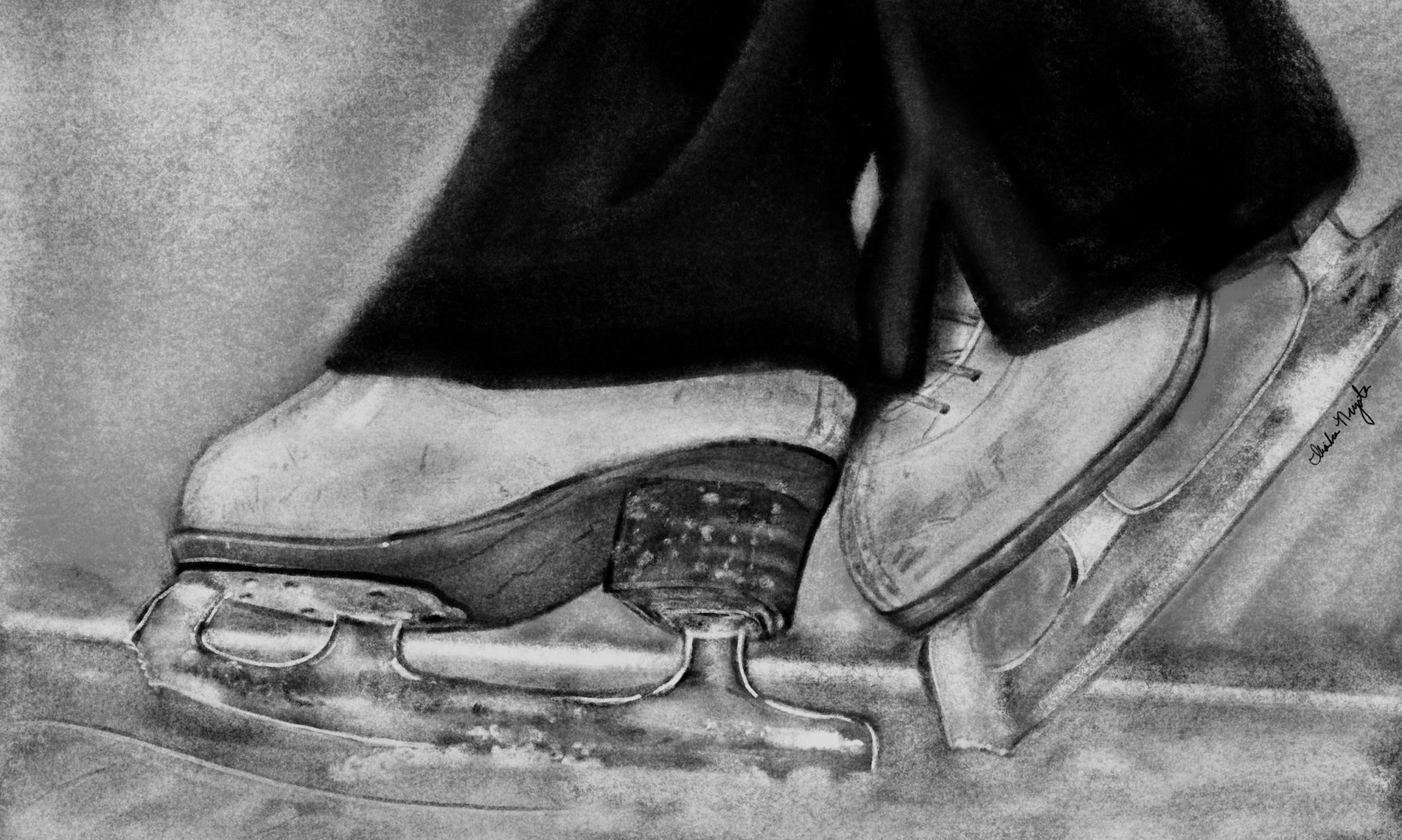New Audio Version.
You can land amazing jumps on some days, but imitate the Zamboni on others. Some days your performance even fluctuates from one session to the next.
Some of those falls really hurt. You practice your jumps every day to become more consistent, but still, when you get on the ice, you are afraid of falling on your hip again. And now, even though it’s never happened, you can’t stop worrying that you might hit your head.
Lately, when it’s time for you to practice your jumps, all you can think about is the possibility of hurting yourself badly if you fall wrong. You try to ignore these negative thoughts. You tell yourself, “I’ve never been injured badly before, so stop being dumb.” But the thoughts keep popping up.
On the ice, you pop jump attempts; you skate tight on your jump patterns. There is no flow. After a pop or two, you start to tell yourself encouraging things like, “just do it,” or “okay, this time I will jump,” maybe you even remember to take a deep breath before you try to jump again.
A few more times circling the ice, a two footed jump and another pop. Now you are even more tense and frustrated. You body responds to your attempts to “pull yourself together,” by making your shoulders climb up to your ears, and your muscles tense up.
Eventually your body is so tight that there is no way you can jump well. For successful jumps, a skater’s body must be relaxed and ready, much like a softball player in the outfield rises onto the balls of her feet as the pitcher releases the ball, ready to move in any direction after the ball is hit.
Muscles that are tense must overcome this initial tenseness before they can fire correctly to facilitate jump mechanics. This takes time, not much, but jumps require seconds to complete, so any delay will cause problems.
If you have studied Physics, you’ve probably heard of Newton’s Law of Inertia:
An object at rest will remain at rest unless acted on by an unbalanced force. An object in motion continues in motion with the same speed and in the same direction unless acted upon by an unbalanced force.
We can say that, objects resist changes in their state of motion, and would rather just they keep on doing what they’re doing.
Have you ever noticed that this “law” also holds true in life? Let’s adapt it to our mental game work:
A skater will resist change in the way they think or feel, and would rather keep on doing what they’re doing.
A skater will continue to think, feel (and skate) the same way unless they act upon these thoughts to move them in a different direction.
Let’s get back to our situation.
Your muscles are tense, your breathing is shallow and fast. You start to panic because you feel like you can’t catch your breath and wonder if something is wrong with you. Why can’t you stop feeling this panic.
Even though you have landed this jump on and off for the last month, you start to tell yourself these stories in your mind:
Will I ever be able to do this jump again?
There must be something wrong with me, maybe I can’t ever learn this jump.
If I can’t get this jump, I will never reach my dream of being an international skater.
I’m such a failure.
I should just quit.
Once started, your mind and body continue to cycle this way, downward into despair, and before you know it, you have decided to quit…again.
You will continue to tell yourself these stories until you take action and do something to move the direction of your thoughts in a different direction.

The sooner the better.
Just like chasing the run-away ball it is easier to stop it before it rolls, than after it has gained momentum. In fact, as soon as you recognize the potential for the ball to escape, it’s easier to take steps to prevent it with a well-placed barrier, or by adjusting your playing position before it happens.
Recognizing potential pitfalls in your thinking and being able to transform your negative thoughts into productive thoughts can be accomplished by working on your mental game every day.
Set the Foundation
The first thing to do is to make sure that you are healthy. This means that you are eating enough, sleeping well, drinking enough water, and have no limitations in movement to cause your jump inconsistencies. If you are injured, and worried that you will injure yourself more, get checked out and cleared by a qualified professional.
If you are afraid of hurting yourself when you fall, or if you are in too much pain when you fall, think about using crash pads to help mitigate the impact.
Many skaters do not want the stigma of wearing a helmet or an Ice Halo, but if you are afraid of hitting your head when you fall, consider investing in and using an Ice Halo until you feel more confident in landing your jumps.
When a skater is unsure or afraid of falling, they can start to jump tentatively. Any coach can tell you that this can create worse falls than when a skater falls after fully committing to a jump.
You will be more willing to commit to your jumps if you are healthy and feel confident that you have done all you can do to be protected.
Take It to the Ice
You have taken steps to protect your body and given your mind some relief from the anxiety (real or imagined) about severely hurting yourself when you fall. Now it’s time to take action to improve your jump consistency.
Narrow the problem down. Is there a specific reason you are inconsistent such as your axis or head position, is it your approach pattern or lack of body awareness?
Are you inconsistent in all of your jumps, or maybe just edge jumps, or toe jumps?
Does this inconsistency only happen when you come back from vacation or after a competition?
Is it really just one jump that is giving you problems?
Do you have a history of injury in a body part that is used for this jump?
Many times skaters will come to me saying that, “everything is terrible,” but when we take a closer look, it’s really only one or two specific things at the root of the problem.
It is common for athletes to have one negative experience, like a poor competition at one rink, and then blow it out of proportion, until they are sure that they will never have a good skate at that rink.
Another common example is when a skater fails to land a double axel in her competition warm up. She dwells on this and works herself into believing that she won’t be able to land the double axel in her short program, her long program and never again in her career because she is such a terrible skater.
Taking one mistake or failure, and turning it into a “law” or a “part of your identity” is called “overgeneralization.” It is “stinkin’ thinkin’,” and when you can recognize it, you can start to refute it and get yourself back on track.
When you pinpoint the true difficulty you are having, you can gain confidence knowing what you can do. For example, when you realize that you can do all of the other jumps, you can use that confidence to tackle the one that is giving you trouble.
Prioritize
Make sure your fundamentals are sound. If your axis is not excellent, your rotation position is not tight enough, or your core is wobbly, this will affect all of your jumps negatively. You need to identify and start to work on your fundamentals until you are consistent. This strong foundation will build your confidence.

If you have sound fundamentals, and have difficulty with one jump, take the jump and break it down into smaller pieces so you can work on making improvements in small steps with the guidance of your technical coach.
- Identify where your jumps breakdown.
- Come up with a list of improvements you need to make in order to land the jump.
- Prioritize by listing the most important correction you need to make first.
- Take the first thing on your list.
- Ask your coach for exercises and tips for improving this skill.
- Write a process goal by asking yourself, “What is the one thing I need to do to jump successfully?”
- Work on that one thing every day, with enough repetitions to make changes.
- Everyday, as you work on the skill, do it with tunnel vision. This means to act like a horse wearing blinders. Only focus on what is right in front of you at the moment.
- Do your repetitions; avoid making judgments about how well or poorly you are doing or if you are progressing fast enough.
- Practice purposefully. Each time you repeat the exercise, focus on making the correction until it becomes automatic.
- Move to the next item on your list.
When you have a strong mental game, you will notice more great days and fewer difficult days. More great days lead to getting more done on the ice.
Investing in your mental game is one of the best things you can do for yourself if you want to become the skater you dream of. Start by doing these steps:
- This week, find one thing you want to improve.
- Walk through the steps of narrowing your focus, and make your process goal.
- Practice the one thing that will improve this skill each day this week.
If you have questions about this or want to learn more about mental game coaching, contact me.
